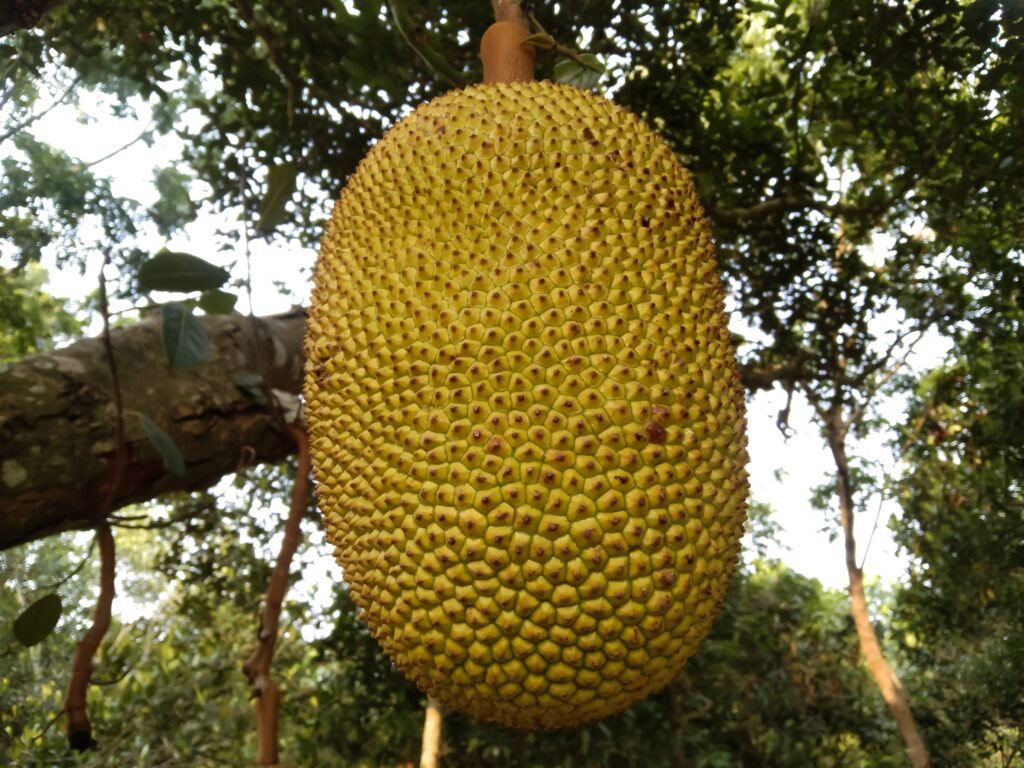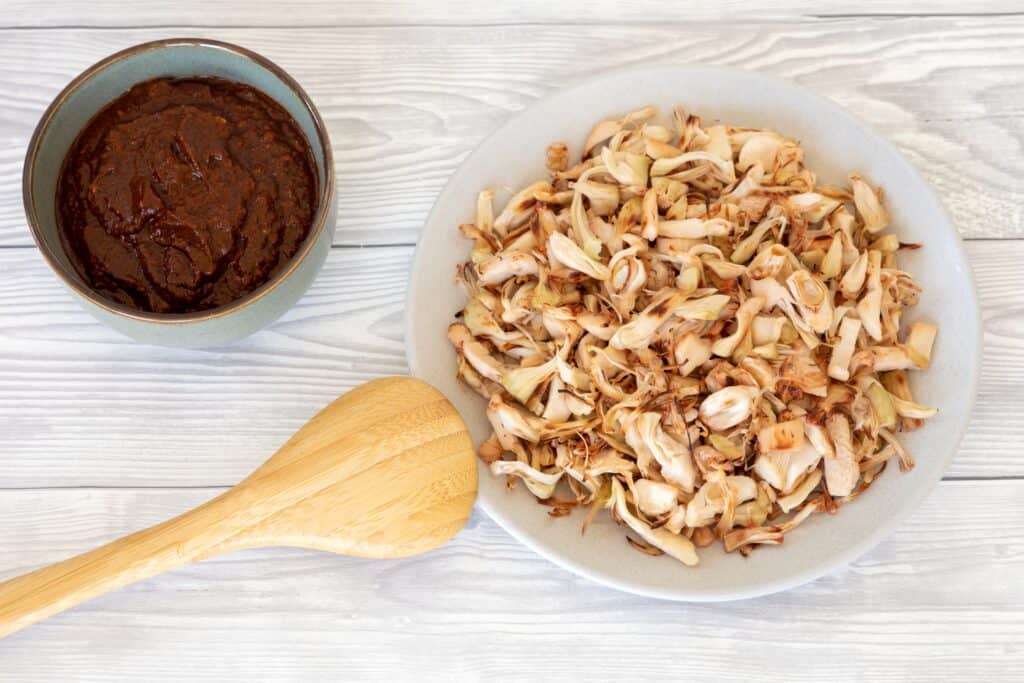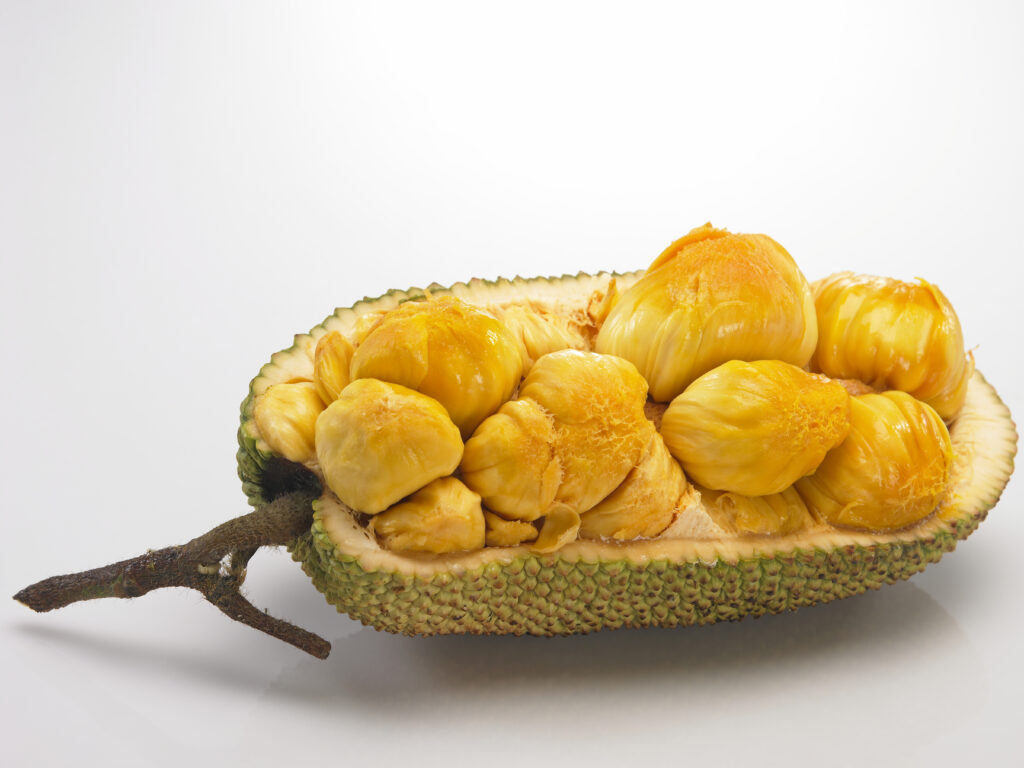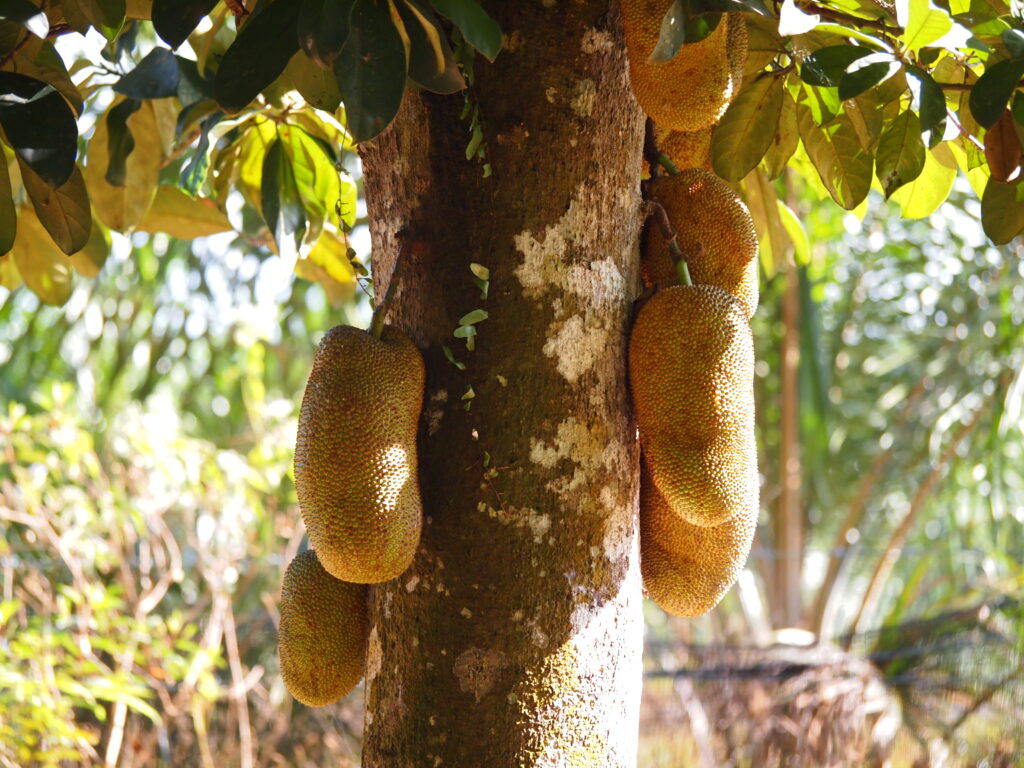Jackfruit has become quite popular in recent years, especially as a meat alternative. It’s a surprisingly versatile fruit for vegan and vegetarian diets, but it has also been used in Southeast Asian cuisine for a very long time. Its cousin, the cempedak, is often confused for the jackfruit. However, while these two fruits look almost identical, they are very different.
In this guide, we’ll explore the differences between the cempedak and the jackfruit. Growing them can be tricky outside of tropical climates, but it’s certainly not impossible. If you’re interested in growing either of these tasty fruits, keep reading to learn about their key differences.
Comparing Cempedak vs. Jackfruit
| Cempedak | Jackfruit | |
|---|---|---|
| Classification | Artocarpus integer | Artocarpus heterophyllus |
| Alternative Names | Chempedak | Jack Tree, Jaca, Nangka |
| Origin | Southeast Asia | India, Southeast Asia |
| Description | A type of evergreen tree that produces fruit and is widely cultivated in Malaysia and other Southeast Asian countries. | A fruiting tree species that produces very large fruits that are common in Southeast Asian cuisines. |
| Uses | Mostly used for cuisine, though the timber of this tree is also used for building furniture, boats, and houses. | Mostly used for cuisine, especially as a plant-based meat alternative in the West. |
| Growth Tips | Always space seedlings apart, as this will improve fruiting. | Always plant in well-draining soil and in a spot where this plant can receive full sun. |
| Interesting Features | Cempedak trees are similar to jackfruit, just smaller and sweeter. | The jackfruit is the largest tree fruit in the world. |
The Key Differences Between Cempedak and Jackfruit
In many aspects, cempedak is comparable to jackfruit. The genus Artocarpus applies to both of them. Additionally, they are both from various regions of Asia. But the plants themselves differ noticeably.
The peduncle of the cempedak tree is narrower, and the cempedak fruits are smaller than jackfruit. In contrast to the dark green of jackfruit, the male inflorescence of cempedak is pale green to yellow. When ripe, the cempedak’s flesh turns a darker yellow and is juicier. When compared to cempedak fruit, which has a maximum weight of roughly two pounds, jackfruit can weigh up to 40 pounds per fruit, though they can get even heavier.
The jackfruit is also more widely available on a global scale since it has gained popularity as a meat alternative made from plants, especially when it is brined and canned. Even though cempedak is much more difficult to locate than jackfruit, it can be found in the West.

The peduncle of the cempedak tree is narrower, and the cempedak fruits are smaller than jackfruit.
©noraismail/Shutterstock.com
Cempedak vs. Jackfruit: Classification
Cempedak is classified as Artocarpus integer. Jackfruit is classified as Artocarpus heterophyllus. Both plants are part of the Moraceae family, which means they are both related to plants such as the fig, breadfruit, and mulberry.
Cempedak vs. Jackfruit: Description
The cempedak is a tropical fruit that is edible in both its unripe and ripe phases. Westerners enjoy it as a unique treat due to its unusual appearance and incredibly strong aroma and flavor. The aroma of cempedak is particularly peculiar. The cempedak fruit measures 10 to 17 inches in length and 4 to 6 inches in width. It ranges in weight from two to thirteen pounds. The cempedak has dull, fleshy spines and a skin pattern of tiny hexagons, giving it the appearance of an extended melon. When young, the skin is rough and green; when ripe, it is yellow or pale orange.
Jackfruit is related to cempedak, and its name refers to both the tree and the fruit it produces. Jackfruit can be found growing on 65-foot-tall trees’ branches and trunks. Small, floral pods called jackfruit first appear on the ends of erect, green stalks. The blooms disintegrate as they grow and mature, exposing hundreds of tiny, hard protrusions in the shape of cones. When fully grown, jackfruit can reach lengths of up to 40 inches, a width of 20 inches, and a weight of up to 40 pounds or more. Jackfruit is frequently plucked before it is fully mature because when it is, it will fall off the tree and could crush someone. The bright yellow bulbs that make up the jackfruit’s edible section are located inside the fruit, just below the rind.

When fully grown, jackfruit can reach lengths of up to 40 inches, a width of 20 inches, and a weight of up to 40 pounds or more.
©Arif biswas/Shutterstock.com
Cempedak vs. Jackfruit: Uses
Cempedak is mostly consumed as a meal. It tastes fruity, resembling a soft banana or pineapple. The cempedak tree produces robust wood that is used to construct houses, boats, and furniture. Buddhist monks’ robes are dyed using the yellow sap from the heartwood in Cambodia, Laos, and the Mekong Delta in South Vietnam.
People consume the jackfruit tree’s fruit and seeds for food or as a kind of medication. However, in the West, it is mainly utilized as a meat substitute. For diabetes or as an aphrodisiac, jackfruit is consumed orally. To treat poisonous bites, jackfruit paste is applied to the skin. Additionally, furniture and musical instruments can be made from the wood of the jackfruit tree.

Jackfruit has gained popularity for use as a meat substitute.
©Fotema/Shutterstock.com
Cempedak vs. Jackfruit: Origin
Southeast Asia is the natural home of cempedak trees. Cempedak has the potential to be used in various regions and is a significant crop in Malaysia. It is also widely grown in Southern Thailand and some regions of Indonesia. Currently, only Southeast Asia is the home of the cempedak, though there are a few trees in Australia and Hawaii.
Jackfruit is a native of the Western Ghats of Southern India, all of Bangladesh, Sri Lanka, and the rain forests of the Philippines, Indonesia, and Malaysia. It is thought to have originated in India. Although not frequently grown here, jackfruit can be found in South Florida and Hawaii.

Cempedak tastes fruity, resembling a soft banana or pineapple.
©focal point/Shutterstock.com
Cempedak vs. Jackfruit: How to Grow
Cempedak trees thrive in areas with an annual rainfall average of about 100 inches. Because of its high humidity requirements, it is challenging to grow outside of Southeast Asia. Sand and clay-based well-irrigated soil are preferred by cempedak trees. It should have little sand and be loose. The ideal pH range for this tree is between 6.0 and 7.0, yet the trees can withstand acidic soils. The seeds that are taken from mature fruit on the cempedak tree are the best. Grafting is another method of propagation. After six months of consistent watering, saplings should be prepared for transplantation. The trees may grow to a height of 4250 feet above sea level and do best in lowlands.
Plant your jackfruit seeds in soil after soaking them in water for the night. The germination period for jackfruit seeds is three to eight weeks. The seedlings can be planted outdoors or inside, however, you should transplant a jackfruit seedling when it has no more than four leaves. Although the soil can be sandy, sandy loam, or rocky, jackfruit trees prefer full sun and well-drained soil, and they can handle all of these conditions. It will not put up with roots that are submerged. A jackfruit tree might die from too much water.

Cempedak trees need high humidity and abundant rainfall making it challenging to grow outside of Southeast Asia.
©Tu7uh, CC BY 3.0 <https://creativecommons.org/licenses/by/3.0>, via Wikimedia Commons – License
Cempedak vs. Jackfruit: Special Features
Cempedak is a monoecious, medium-sized, mid-canopy, evergreen tree. The plant prefers a rather high water table, but it may grow in humus-rich, loamy, acidic, and well-drained soils. Cempedak trees produce blooms that are monoecious, meaning that they produce both male and female flowers on the same tree. On a single stalked inflorescence, which can be found at the leaf axil, on the tree trunk, or on the branches, the flowers are produced.
Jackfruit is particularly abundant in vitamin C, vitamin A, riboflavin, thiamin, potassium, calcium, sodium, zinc, and niacin. Young jackfruit pulp is used to make vegetable dishes that may be pickled or canned. It is employed in the production of paste, jam, and chutney. Additionally, ice cream and beverages are flavored using its pulp.
Both of these plants are difficult to grow in the United States, but it is certainly not impossible. If you have the space for the large and heavy jackfruit tree, by all means, start growing it! If you prefer something smaller and more manageable, the cempedak tree may be a better choice. Either way, the cempedak and jackfruit trees are excellent fruit-bearers.
Up Next
The photo featured at the top of this post is © focal point/Shutterstock.com
Sources
- Wikipedia, Available here: https://en.wikipedia.org/wiki/Jackfruit
- Wikipedia, Available here: https://en.wikipedia.org/wiki/Artocarpus_integer
FAQs (Frequently Asked Questions)
Are cempedak and jackfruit the same plant?
No. They are both part of the genus Artocarpus, but are different species.
Is cempedak healthy?
Cempedak fruit is very rich in fiber, potassium, and lots of antioxidants, making it an excellent fruit for heart health.
Is jackfruit healthy?
Jackfruit has some healthy attributes, such as fiber, protein, vitamins C and B, and even potassium. It is an excellent fruit for balancing blood sugar.
Thank you for reading! Have some feedback for us? Contact the AZ Animals editorial team.






